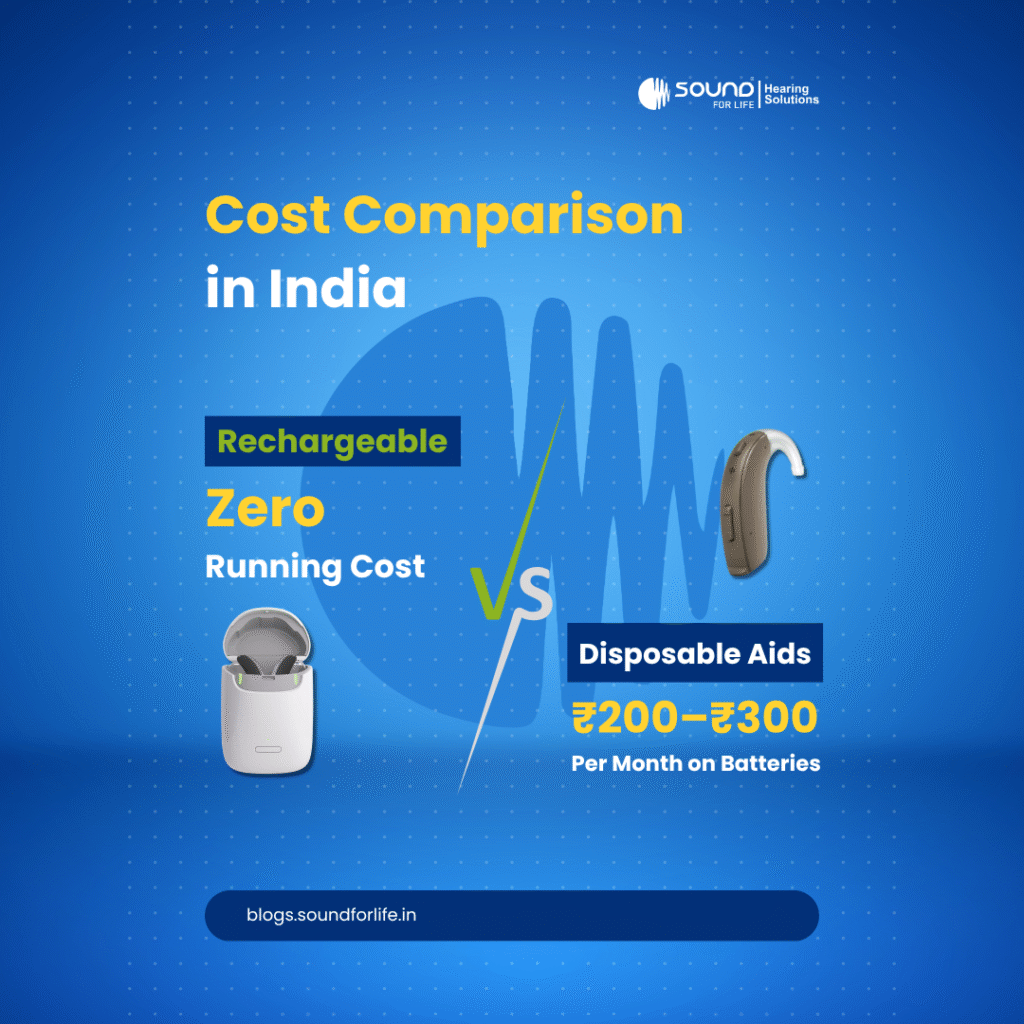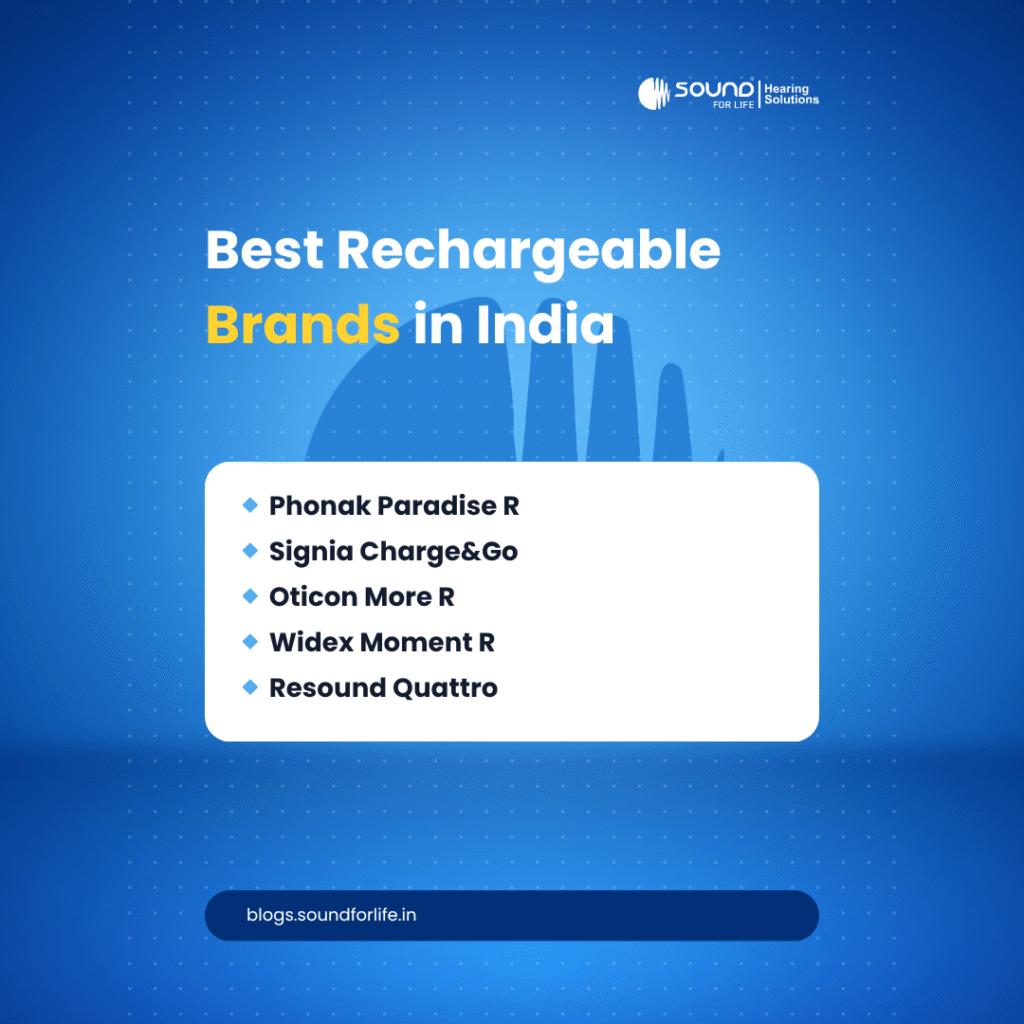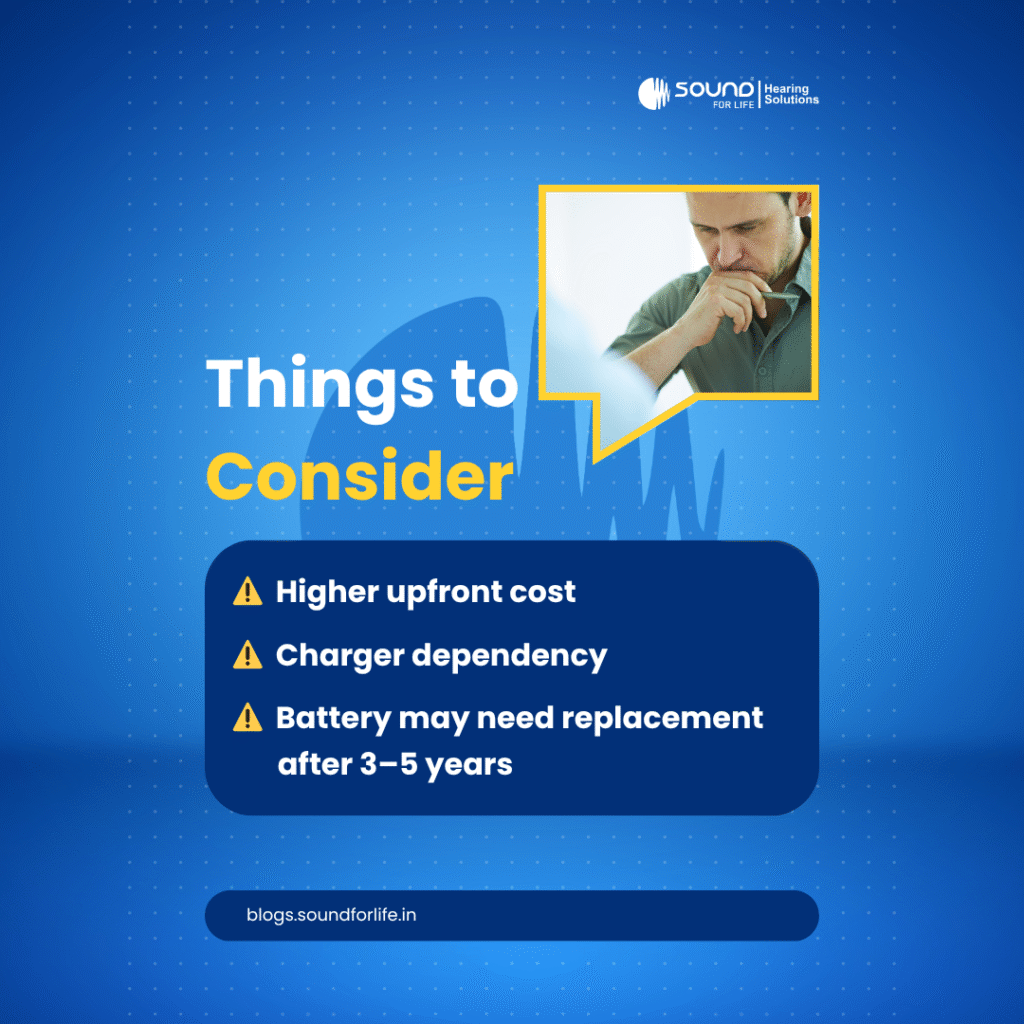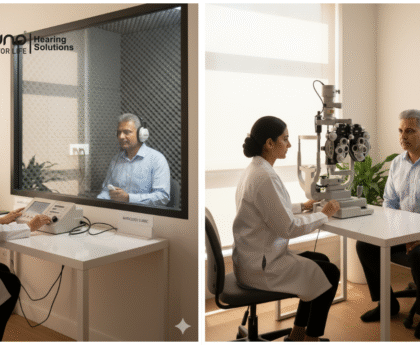Hearing loss can make it hard to do things like chat to people you care about, listen to music you like, or follow along with a movie’s dialogue. Hearing aids used to run on batteries that needed to be replaced often, which was both expensive and inconvenient. But in the last few years, rechargeable hearing aids have changed the game. We’ll talk about what rechargeable hearing aids are, how they work, their pros and cons, how much they cost in India, and whether or not they’re the right choice for you.

1. What do rechargeable hearing aids do?
Rechargeable hearing aids operate much like ordinary hearing aids, except they feature built-in batteries that can be charged (typically lithium-ion) instead of small cells that need to be thrown away. Every night, or whenever you’re not using them, you just put your hearing aids in a charging station. They’ll be ready to use the next morning. You won’t have to worry about running out of power at the worst moments or dealing with tiny batteries anymore.
Important parts
Battery built in: Sealed inside the hearing aid case to keep out water and dust
Charging station: A lot of the time, it also serves as a protective case.
Battery indicator: LED lights on the charger or hearing aid show how much battery is left.
2. How do they work? A Quick Look at the Technology
Rechargeable hearing aids use the same advanced digital signal processing algorithms as hearing aids that run on disposable batteries. The only real difference is where the power comes from:
Batteries that use lithium ions: Most modern rechargeable hearing aids use small lithium-ion cells, just like smartphones and laptops.
Smart charging circuitry controls voltage and current to stop overcharging and extend the life of the battery.
Quick-charge features: Some models have a “30-minute boost” that gives you several hours of use from a short charge.
The built-in batteries usually last 18 to 30 hours on a full charge, depending on how you use them, such as streaming music over Bluetooth, blocking out noise, and turning up the volume.

3. Rechargeable hearing aids have these benefits:
3.1 Easy to Use and Convenient
No more messing with batteries: You won’t have to deal with tiny batteries or a magnifying glass anymore. Just like charging your phone, all you have to do is put your aids in the charger every night or whenever you are not using them.
Stable performance: The voltage stays the same from full to almost empty, so there are no sudden drops in volume.
3.2 Cost-Effectiveness Over Time
Lower running costs: Rechargeable models may cost ₹5,000–₹10,000 more up front, but you save on disposable batteries (₹200–₹300 per pack) every month.
Fewer service calls: Some hearing aid specialists say they get fewer “battery-related” calls for service.
3.3 Being good for the environment
Less waste from batteries: Every year, millions of button cells are thrown away. Rechargeables make that smaller.
Sustainable materials: Top brands are working on chargers that use less energy and packaging that is better for the environment.
3.4 More Reliable
No surprises with the power at noon: When your built-in batteries are running low, they usually work as expected and give you clear signs.
Water and dust resistance: Sealed battery compartments usually have higher IP ratings for durability.

4. Comparing Prices: Rechargeable vs. Disposable in India
| Cost Category | With Disposable Batteries | Rechargeable |
| Upfront Cost | Lower by ₹5,000–₹10,000 | Higher by ₹5,000–₹10,000 |
| Monthly Running Cost | ₹200–₹300 (batteries) | Nil (electricity cost negligible) |
| Annual Cost (approx.) | ₹2,400–₹3,600 | ₹0–₹100 (electricity) |
| Battery Waste | High | Very low |
| Service Calls (battery issues) | Moderate | Low |
For example, If you buy four packs of batteries a year and spend ₹250 on each pack, that’s ₹1,000 a year only on batteries. Over the course of five years, you’d spend ₹5,000 on batteries, which is enough to make up for most of the price difference between a rechargeable model and a regular one.

5. The best rechargeable models you can buy in India
A number of Indian and international brands now sell hearing aids that can be recharged. Some well-known names are:
Phonak Audeo Paradise R
Charge and Go X from Signia
More R from Oticon
Widex Moment R
Rechargeable Resound LiNX Quattro
When you compare models, look for:
Battery life: 18 hours or more is best, especially if you listen to music.
Quick charge: You can charge it quickly in 30 minutes in case of an emergency.
Bluetooth Connectivity: Bluetooth lets you stream wirelessly to your phone or TV.
IP rating: To protect against moisture better.
Guarantee: At least two years, including how well the battery works.

6. Things to think about before you buy
Rechargeable hearing aids come with a lot of benefits, but they might not be the ideal option for everyone. Consider these things:
Investment Up Front: Plan your budget ahead of time as the initial cost might be higher.
Charger Dependency: If you lose your charger, you will have to borrow one or find another means to charge the device.
How long do batteries last?
Lithium-ion batteries lose power over time, usually between 3 and 5 years. Check out the many possibilities for replacements and how much they cost.
Travel Needs:
Make sure your charger works with India’s 230 V outlets. If you travel abroad, you might want to think about getting adapters.
Some experts suggest that you should always have a small pack of disposable batteries on hand in case of an emergency.
7. Common Myths: Debunked Myth: Reality
Myth:
“Streaming can’t be done with rechargeable hearing aids.”
Reality:
Most modern rechargeable models can stream for 8 to 10 hours on a single charge.
Myth:
“Batteries that come with the device die faster.”
Reality:
If you take good care of them, lithium-ion batteries will still have 80% of their capacity after 3 to 5 years.
Myth:
“They don’t resist water.”
Reality:
A lot of rechargeable aids have IP68 ratings, which means they are protected from dust and water.
Myth:
“They’re only for people who know how to use technology.”
Reality:
To charge them, all you have to do is put them in the dock. No special skills are needed.
8. Are hearing aids that can be charged worth it?
Here’s a brief overview after looking at the pros and cons:
Advantages:
- Charging is easy and only takes one step.
- Power that is stable and predictable all day
- Costs of running go down over time
- Less battery waste and better for the environment
- Options for wireless connections that work without problems
Disadvantages:
- More money up front
- Dependence on charger (but backup plans help with this)
- Battery degradation over time (which happens to all rechargeable devices)
Final:
Rechargeable hearing aids are a good investment for most people, especially those who stream audio, don’t like dealing with small batteries, or want a more eco-friendly option. They are convenient and save money in the long run, and they are reliable.
9. How to Pick the Best Rechargeable Hearing Aid in India
Talk to an Expert
- You can get a full hearing test at a certified centre like SFL Hearing Solutions.
- Talk about your daily habits, how much you stream, how long you wear it, and how well you can use your hands.
Look at the features
- Battery life compared to streaming time
- IP rating (how well it resists moisture)
- Smartphone app compatibility for making small changes
Try it out first
- Many centres let you try the aids out in real life before you buy them.
- Look into After-Sales Support
- The hearing aid and battery come with a warranty.
- Availability of spare batteries or chargers to borrow
10. Tips for keeping things in good shape for a long time
Charging every day: Add it to your bedtime routine.
Clean the Contacts: Once a week, wipe the charging pins with a soft cloth.
Store in a Dry Place: Don’t leave them in a humid place when you’re not using them.
Updates for Software: Use the app from your hearing care professional to keep the firmware up to date.
Regular Maintenance: Set up check-ups every 6 to 12 months.
11. Conclusion
Rechargeable hearing aids are more than just a lovely enhancement; they indicate that people are becoming more responsible about the environment, saving money, and making things easier. As India’s hearing-care system changes, they are quickly becoming the first choice for both professionals and regular people.
It’s time to think about rechargeable hearing aids if you don’t want to keep changing batteries, need a consistent power supply for Bluetooth streaming, or just want a more environmentally friendly option.
Are you ready to make the change?
SFL Hearing Solutions is an expert at fitting the newest rechargeable hearing aids to fit your lifestyle and hearing needs.
Our experts offer:
- Full hearing tests
- Recommendations for devices that are right for you
- Free trial periods so you can see the benefits for yourself
- Support and maintenance that never ends





